

NeuroSky Developer. OpenEEG project. About the project Many people are interested in what is called neurofeedback or EEG biofeedback training, a generic mental training method which makes the trainee consciously aware of the general activity in the brain.
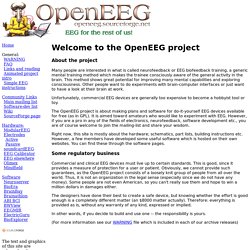
This method shows great potential for improving many mental capabilities and exploring consciousness. Other people want to do experiments with brain-computer interfaces or just want to have a look at their brain at work. Unfortunately, commercial EEG devices are generally too expensive to become a hobbyist tool or toy. The OpenEEG project is about making plans and software for do-it-yourself EEG devices available for free (as in GPL).
Right now, this site is mostly about the hardware; schematics, part lists, building instructions etc. Some regulatory business Commercial and clinical EEG devices must live up to certain standards. In other words, if you decide to build and use one -- the responsibility is yours. Arduino-Brain-Library. EEGLAB. EEGLAB provides an interactive graphic user interface (GUI) allowing users to flexibly and interactively process their high-density EEG and other dynamic brain data using independent component analysis (ICA) and/or time/frequency analysis (TFA), as well as standard averaging methods.
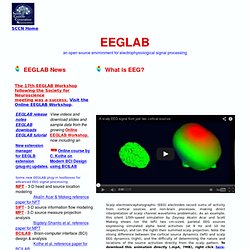
EEGLAB also incorporates extensive tutorial and help windows, plus a command history function that eases users' transition from GUI-based data exploration to building and running batch or custom data analysis scripts. EEGLAB offers a wealth of methods for visualizing and modeling event-related brain dynamics, both at the level of individual EEGLAB 'datasets' and/or across a collection of datasets brought together in an EEGLAB 'studyset.' For experienced Matlab users, EEGLAB offers a structured programming environment for storing, accessing, measuring, manipulating and visualizing event-related EEG data. EEGLAB Statistics EEGLAB Workshops EEGLAB Development Feedback? Intendix. ElectricGuru. BCI2000. What is BCI2000?
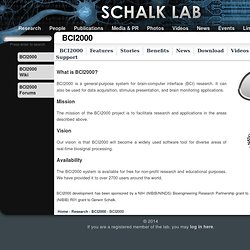
BCI2000 is a general-purpose system for brain-computer interface (BCI) research. It can also be used for data acquisition, stimulus presentation, and brain monitoring applications. Mission The mission of the BCI2000 project is to facilitate research and applications in the areas described above. Vision Our vision is that BCI2000 will become a widely used software tool for diverse areas of real-time biosignal processing.
Availability The BCI2000 system is available for free for non-profit research and educational purposes. BCI2000 development has been sponsored by a NIH (NIBIB/NINDS) Bioengineering Research Partnership grant to Jonathan Wolpaw and a NIH (NIBIB) R01 grant to Gerwin Schalk. OpenBCI - Open Source Biosensing Tools (EEG, EMG, EKG, and more) Brain DJVJ for iPhone. Puzzlebox. Np_mindset by Machulis. NPLabs Max/MSP + Pd Externals by Machulis. Mind your OSCs. Processing EPOC via OSC by Madara. Related articles: AffectCircles How would you like to create interactive art that responds to your thoughts, moods, and facial expressions?
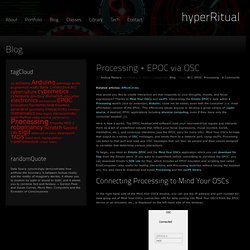
Thanks to Mind Your OSCs and oscP5, interpreting the Emotiv EPOC‘s data within a Processing sketch (and by extension, Arduino) could not be easier, even with the consumer (i.e. most affordable) version of the EPOC. This effectively allows anyone to develop a great variety of (open-source, if desired) EPOC applications including physical computing, even if they have only the consumer headset [1].
Here is how it works. The EPOC headset and software read your neuroelectrical signals and interpret them as a set of predefined outputs that reflect your facial expressions, mood (excited, bored, meditative, etc.), and conscious intentions (see the EPOC docu for more info). To begin, you need an Emotiv EPOC and the Mind Your OSCs application which you can download for free from the Emotiv store.
Each OSC message sent from Mind Your OSCs has three parts: Np_epoc by Machulis. Np_epoc Max/MSP + Pd Externals by Machulis. Emokit download. Processing-Brain-Grapher. GlovePIE. EmoRate by AT. Future Applications EmoProfiles The list of potential applications for Affective Computing aka Computing With Emotions is incredible.

As the technology develops people will develop EmoProfiles, profiles of their emotional reactions to videos, songs, books, reviews, anything and everything that sparks an emotional reaction (which basically is everything since we are emotional beings). The definition I have come up with for an EmoProfile: “An EmoProfile is a profile that contains data cataloguing your emotional reactions to various stimuli, tagged by keywords and other ontological aids and statistics, in a manner that allows one profile to be compared with another or a group of other profiles digitally by any reasonable computing device.”
As adoption of EmoProfiles spreads they will become powerful tools for predicting what someone likes and dislikes, and how compatible people will be with each other and when interacting in a group. Emotion Based Recommendation Systems Emotion Guided Search. Emolens by AT. EEGMIR by Peters. IBVA softwares. Hack Toy EEGs by Mika. Arturo Vidich, Sofy Yuditskaya, and I needed a way to read brains for our Mental Block project last fall.
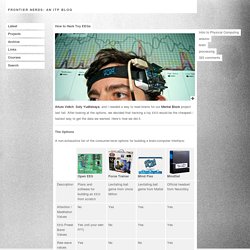
After looking at the options, we decided that hacking a toy EEG would be the cheapest / fastest way to get the data we wanted. Here’s how we did it. The Options. BioSig. Neuro.debian. BioEra.